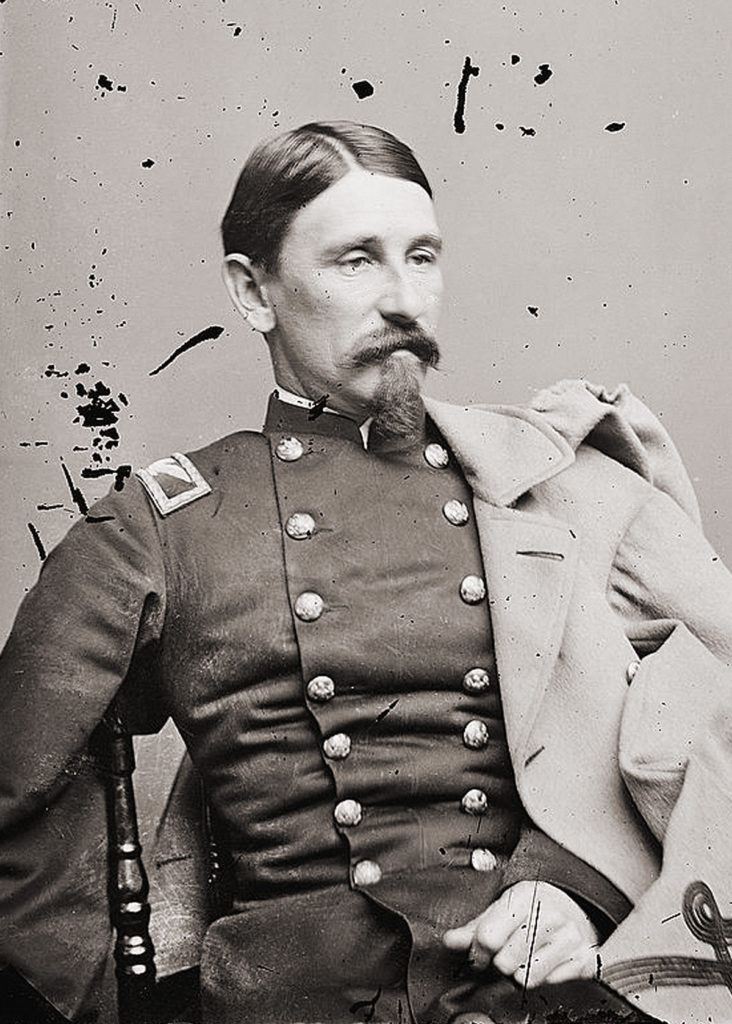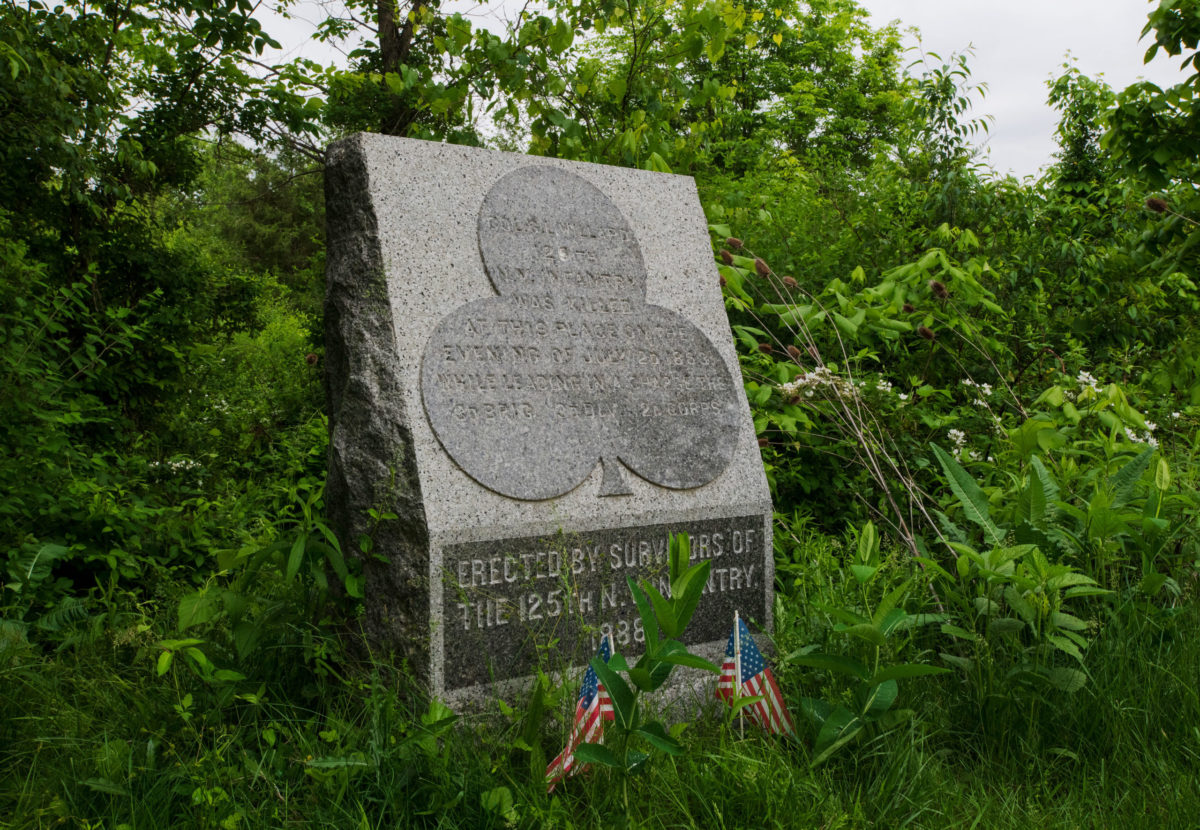Tracking down obscure monuments is a popular activity for those who enjoy tramping Gettysburg’s fields. One of the least visited in the heart of the battlefield is the simple four-foot granite monument marking the approximate location where Colonel George Willard—commanding the 3rd Brigade, 3rd Division, 2nd Corps of the Army of the Potomac—was killed on July 2, 1863. It was erected in 1888 by survivors of the 125th New York, the regiment Willard commanded before assuming brigade command.
The reason this monument is so seldom visited is two-fold; Willard is a relative unknown and it requires a hike of several hundred yards across an uneven meadow to what is known as the Codori-Trostle thicket. Since there is no well-trodden path, once you reach the thicket it can take a few minutes of hunting to locate the monument.
Chaplain Ezra D. Simons, the 125th New York’s historian, called Willard the “embodiment of a true soldier—strict when on duty, cool amid danger, of oft-proven bravery, respected alike by subordinates and superiors.” Simons’ history was published the same year Willard’s marker was placed. In their own way, both reflected how time, and death on a battlefield, can soften opinions, for initially the unit’s soldiers utterly despised their colonel.
Willard came from a military family, but his father preferred he pursue a business career. Nevertheless, when the Mexican War came, George enlisted and would distinguish himself at the 1847 Battle of Chapultepec. On the recommendation of U.S. Army commander Winfield Scott, he earned a commission to the 8th U.S. Infantry.
On August 15, 1862, the 35-year-old Willard made the jump from the Regular Army to the Volunteer Army and was appointed colonel of the new 125th New York. Although some Regular Army officers conceded that working with and motivating volunteers was different than regulars, Willard was not one of them. A rigid disciplinarian, he quickly earned his men’s hatred.
Unit morale was not improved by the Union debacle at Harpers Ferry in September 1862, when the 125th surrendered with the rest of the garrison to Maj. Gen. Stonewall Jackson. The 125th was sent with the other Union prisoners to Camp Douglas’ parole camp in Chicago, where they were confined until they could be exchanged. They became known collectively as the “Harpers Ferry Cowards,” only adding to their demoralization. Finally in November they were exchanged and sent to Washington, D.C. There, the business of reorganizing the regiments and rebuilding morale began.
Willard continued to founder as the regiment’s commander. His lieutenant colonel, Lewis Crandell, wrote in December that Willard “has come to the conclusion that he cannot or has not the faculty to command a volunteer Regt successfully,” and had told the regiment’s adjutant “he would be d—-d if he did not resign as the regt was wholly demoralized.” When Willard took a leave of absence, Crandell noted how the men “have become cheerful, and have done more drilling than they have since we left Chicago.”
The 125th, 126th, 111th, and 39th New York formed what was known as the “Harpers Ferry Brigade,” and in January 1863 received a new commander, Brig. Gen. Alexander Hays. Although he also had been Regular Army, Hays understood volunteers and knew how to make soldiers and build morale. It seems he also helped Willard reset his relationship with his men.
On June 25, 1863, Hays’ brigade was assigned to the Army of the Potomac, then marching north to confront the Confederate invasion of Pennsylvania. In the reorganization of the army that took place on the march, Hays’ brigade was assigned to the 2nd Corps, with Hays promoted to command of the 3rd Division. The promotion put Willard, as the senior colonel, in command of the brigade. By this point, however, opinions about him had changed. Even though his soldiers accepted that he remained a firm disciplinarian, they had also come to recognize that he displayed “the utmost care for the welfare of his men.”

A week later, at Gettysburg, Willard’s brigade found itself arrayed in a reserve position along the northern end of Cemetery Ridge. The men all hoped for a chance to erase the stain of Harpers Ferry from their reputations. They spent the afternoon of July 2 listening to a furious battle on the Union left. Late in the afternoon, with a general collapse of that flank, troops of the 2nd, 3rd, and 5th Corps began streaming to the rear in retreat. Yawning gaps developed in the Union front that advancing Confederate troops threatened to exploit. It was imperative that those gaps be closed, whatever the cost. As dusk approached, Hays was ordered to send a brigade to the left. He chose Willard, instructing the colonel to “take your brigade there and knock the h— out of the rebs.”
Nearing the southern end of Cemetery Ridge, in the vicinity of where the Pennsylvania Monument stands today, the brigade encountered the confusion brought on by the frantic exodus of 3rd Corps soldiers retreating from the Confederate onslaught. Willard deployed his brigade approximately along the line where Hancock Avenue now runs. “It was difficult to keep a line in the face of these squads of flying men,” wrote one 111th New York soldier, who noted they also faced artillery fire—“terrific” in its intensity. Then, from a thicket about 400 yards to the west, came small-arms fire from Brig. Gen. William Barksdale’s advancing Confederates.
Under orders from corps commander Maj. Gen. Winfield Hancock, Willard directed his brigade forward. Although, as Ben Thompson wrote, “men fell at every step,” the New Yorkers—their bayonets fixed and shouting “Remember Harpers Ferry”—swarmed forward. Despite bullets and enemy shells tearing through “our ranks fearfully,” they drove back Barksdale’s men, mortally wounding the general in the melee, and continued on toward the Emmitsburg Road. As they neared the road, though, shelling from Rebel batteries around the Peach Orchard, as well as friendly fire from Union artillery, forced Willard to order a retreat in order to re-form east of the thicket.
That proved difficult, and losses were heavy. The atmosphere choked with smoke and the noise of artillery deafening, Willard rode among his men, attempting to steady and reorganize them into regimental formations. And then an enemy shell found its mark on the colonel, almost decapitating him. To prevent his sudden, gruesome death from demoralizing the men, Willard’s mangled body was quickly gathered up and carried from the field.
The stigma of Harpers Ferry had been erased, but at a terrible cost. Monuments are about memory. Willard may not have been “loved” by his men, but the granite marker standing in the Codori-Trostle thicket is a fitting reminder that he had earned their respect and that his courage and sacrifice would not be forgotten.
Scott Hartwig writes from the crossroads of Gettysburg.






